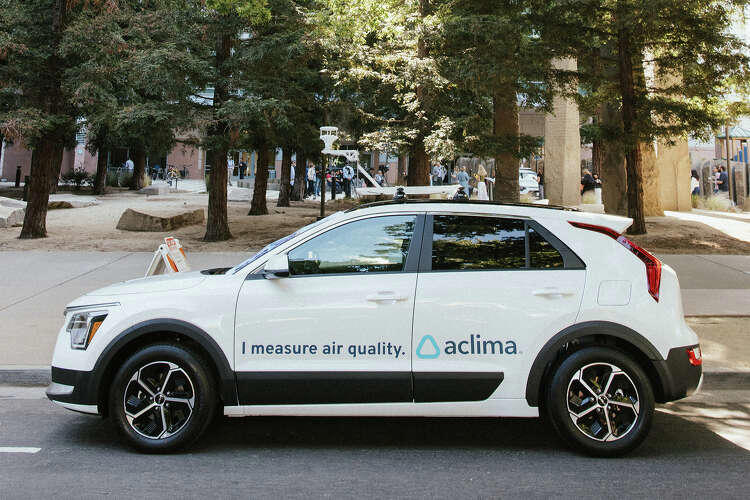Quran Holland is used to people making funny faces or waving at him as he drives around Los Angeles. Sometimes, they even strike a pose.
But the apparatus affixed to the top of the white Kia Niro he navigates through the streets isn't snapping photos or sensing people's movements like a Waymo or a Google Street View car. The white cylindrical gadget on Holland's car measures wind.
"I'm not going to crush their dream, but unfortunately, it's not a camera," Holland says with a laugh.
The wind meter is one of two sensor locations on an Aclima car, both of which feed air quality data back to researchers in a lab operated by UC Berkeley, UC Riverside or private research company Aerodyne. The second is a small black object with a circular opening on the passenger side window that would probably go unnoticed, were it not for the decals declaring "I measure air quality" beside the company logo. The intakes measure air quality every second, looking for 10 pollutants in a manner that differs significantly from how California cities have typically measured air quality.
Instead of measuring air quality at a fixed location, like air quality website PurpleAir, Aclima's mobile units measure pollutants as the car moves, picking up differences on a block-by-block level. In one of the company's earliest studies, in which it mounted its sensors to Google Street View cars, it found that even in a 12 square mile radius of Oakland, air pollution could vary dramatically - up to five to eight times per block.

Now, the Aclima cars are roaming around 64 locations in California as part of a new effort, dubbed the Statewide Mobile Monitoring Initiative, or SMMI, which launched in June. These communities were identified as pollution-burdened areas and will have air quality measured 24/7 for about 10 months. At the end of the measuring period, each location will receive an annual pollutant average, and all the data will be available on an interactive map one day, accessible to the public. The goal is that community organizations and regulators can use that data to inform policy decisions.
A new era of air quality monitoring
Holland starts his day in a mostly vacant Motel 6 parking lot. He opens the trunk of the plug-in hybrid hatchback, which is filled with four boxy machines. He flicks the switches on each of them and a low hum begins. Tubes line one side of the vehicle's ceiling, stretching to the black sensor mounted on the rear window. The lights on the boxes turn red, then green. The process takes about five minutes, while Holland scans the tubing for dust or any other obstructions. After a status check, he searches his tablet for the day's route and attaches it to a dashboard arm, puts on some music, and sets the car into drive.
In the Bay Area, you may spot the cars in West Berkeley, SoMa or on Treasure Island. In LA, one may drive by in Inglewood or Koreatown. Each car is named after a famous musician - Holland drove "Buddy" (named for Buddy Guy) the day we rode along, and J. Lo sat parked nearby.
The cars will eventually cover 950,000 miles in California and reach 5.2 million residents. California cities have the worst air quality in the country, according to the American Lung Association's most recent "State of the Air" report, by all three categories measured - ozone (also known as smog), year-round particle pollution and short-term particle pollution (which includes dust, soot and smoke). The fine particle pollution can make its way into your lungs and your bloodstream, which can cause a host of health issues such as asthma, heart attack or stroke.
